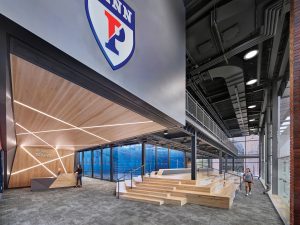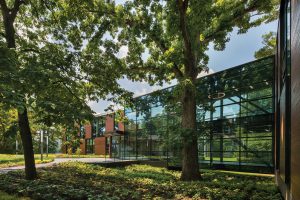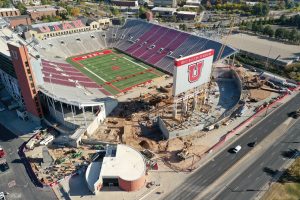COVID AND THE CAMPUS: An insider perspective
When students don’t return to campus, what happens to the buildings? Here facilities executives from three higher education institutions shed light on how COVID-19 has affected the physical campus and their predictions on what’s to come.
Experts Anne Papageorge, Vice President for Facilities and Real Estate Services at the University of Pennsylvania; David Quinlivan, Director of Operations & Logistics at the University of Utah; and Susan Smythe, ADA Program Manager/Senior Project Manager at Swarthmore College have a discussion about changes in universities.
How was your institution affected last spring when the pandemic first took hold?
Papageorge: During our spring break, we informed students that they should not return. Construction projects were halted, and 500 students received exemptions to remain in campus housing. The facilities department went to a skeletal crew of about 10% of our housekeeping and trade staff, on a rotating basis, to ensure the campus was covered for emergencies and to make sure our workforce was safe.
Smythe: We also went virtual during spring break—which was complicated for many reasons. The biggest issue was many students had left campus fully expecting to return, so most left their belongings. On the flip side, we had a lot of students who stayed on campus during break and were now expected to leave on short notice. The residence life staff turned into combination movers, travel agents, and overall supply chain managers, helping students book flights and pack and ship their belongings.
Quinlivan: In March we had a hard stop for in-person classes and moved to online learning for the rest of the semester. Our faculty and IT staff were incredible in creating these platforms in just two weeks.

What measures did you take from a facilities perspective?
Quinlivan: We closed and disinfected most buildings and complied with the State of Utah’s protocols for working from home. Our skilled trades and facility engineering staff were split into two crews and alternated weeks on campus.
Smythe: It was a matter of securing all lo-cations, checking for stocked dorm fridges and open windows, water testing, and setting new criteria for HVAC systems. We also used that period to address deferred maintenance issues and to implement some energy-saving projects, such as converting to LED lighting and upgrading some mechanical systems.
Papageorge: The institution created a Recovery Planning Group. I co-chaired the facilities operations subcommittee. We developed HVAC guidelines, we put many of our buildings in unoccupied mode, and as decisions were made to bring people back, we worked to flush the building water and ensure all systems were functioning properly. We also created housekeeping guidelines and signage guidelines for the campus and our off-campus portfolio.
How did your institution “return” this fall?
Papageorge: The decision early on was to go hybrid. But about two weeks before move-in, because of the challenges in testing availability and reliability and how fluid everything still was, the university decided to go all virtual for under-graduates. What we had planned was to house returning students in singles, keeping freshman and sophomores on campus, and housing juniors and seniors through our master-leased products in the area.
Smythe: There was a recognition that being in person is very important in developing a sense of Swarthmore values and the educational and co-curricular model. A desire to maintain staffing levels also means it’s important to have some students in person. Ultimately, we ended up with about 625 students doing a hybrid model of instruction.
Quinlivan: Our decisions are based on the State of Utah COVID rules, as we are under direction from Governor. We had about 20% of classes in person and then what we call a “circuit breaker” for two weeks in late September. The vice presidential debate was hosted on campus, though, which posed all kinds of logistics challenges for hosting crowds safely. Students will move to full-time remote learning from Thanksgiving until their return in January.

What are some of the biggest changes you’ve had to make on campus?
Papageorge: We’ve been able to do lots of preventative maintenance, work on the buildings that aren’t in use, and other work order back-log. Some faculty are still using their classrooms to teach even though they’re virtual, so the individual schools are working with building administrators and us to tailor an enhanced housekeeping plan—what we call the “road map”—to their specific operations, plus using the social distancing signage kit we developed for the campus.
Smythe: Mostly it’s been about “de-densifying”—removing furniture from spaces, going down to all single rooms, blocking off plumbing fixtures, and adding plexiglass barriers and a LOT of signage. We’ve been changing to all MERV 13 filters, reprogramming HVAC systems to change the balance of outside air/air changes, and remove touch where we can, like adding automatic door openers, new door handles for “hands-free” operation, and turning off all hand dryers.
Is the pandemic affecting your capital plans?
Smythe: Yes. We have already deferred a few projects, and timing is uncertain on others.
Quinlivan: It’s still unknown at this time. We did cut a small percent-age for Fiscal Year 2021, but it will all be reviewed in the January 2021 legislative session.
Papageorge: We approve our budgets in June, so we were just starting that process when COVID-19 hit. The plan went from $600M to $238M. We didn’t put a lot of projects on hold; just pushed some out. Retail has taken a big hit. We have done some rent abatements to try to keep retailers here. One of the benefits of our retail strategy is we have a balance of local and national retailers. The national ones tend to retract during these recessions since they have so many assets. But it’s also an opportunity. Those who are surviving are those who had already made the transition to online retail. That will be even more so.

What other long-term effects do you foresee for the physical campus?
Smythe: We may never go back to having all staff on campus, which might be an opportunity to convert some current office space into academic or student support functions. That may, however, have an impact on sustainability efforts. Plus, the overall financial hit of ad-dressing pandemic needs coupled with investment losses might lead to a longer-term lessening of capital funding.
Papageorge: In our residences, we were already trending toward single-residence suites because that’s what students want. We may also rethink if we still really need swing space during construction projects, which could be a positive since finding swing space is always a challenge. Some efficiencies will definitely come out of this.
